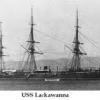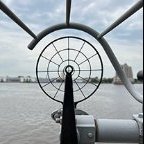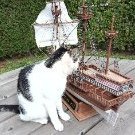
Bob Cleek
-
Posts
3,374 -
Joined
-
Last visited
Reputation Activity
-
 Bob Cleek got a reaction from Frank Burroughs in Beginner looking for advice on first kit
Bob Cleek got a reaction from Frank Burroughs in Beginner looking for advice on first kit
I urge you to take Roger's sage advice in the post above to heart. I completely agree with his observations. If the subject you are modeling doesn't enthuse you to one degree or another through to the end of the build, the end of the build is quite likely not going to happen. As Dirty Harry said, "A man's got to know his limitations."
-
 Bob Cleek reacted to Jaager in Is the Sergal Thermopylae (791) kit any good?
Bob Cleek reacted to Jaager in Is the Sergal Thermopylae (791) kit any good?
David Macgregor drew a set of plans for Thermopylae I believe. His plans went to an outfit that really ain't much of an ally.
Something is available: https://ssgreatbritain.printstoreonline.com/ship-plans/
here is a link here to chase: https://modelshipworld.com/topic/24168-merchant-sailing-ships-serie-david-macgregor/
and another: https://www.ssgreatbritain.org/wp-content/uploads/2021/05/david-macgregor-ship-plans-collection-july-2013.pdf
This said, collect plans, collect books. I think that collecting kits only serves the kit manufacturers. The old pre-fire Mantua kits look to be really awful to me. I think three of their most popular subjects are the same hull in different clothes: Bounty, Endeavor, Beagle. For their kits in general: All of it seems to have been just the minimum required.
A clipper is a major project. A composite hull post 1860 clipper even more of a challenge. Large hulls at a small scale is requiring miniaturist skills. Unless it is a widow recently stuck with "toys" that she resented having funds spent on when obtained, I suspect that "deals" for old kits are gilded bricks. Someone trying to recover some of the money spent on really poor decisions about illusions, dreams, and mirages.
Here is an idea: Keep a diary of subjects as they grab your interest. Have the links and references there. Buy no kits until your board is clear. When you get to the 'buy another kit' stage, you will be surprised at the number of diverse trails, strange ideas, and dry holes there are in the diary.
-
 Bob Cleek got a reaction from Scottish Guy in Beginner looking for advice on first kit
Bob Cleek got a reaction from Scottish Guy in Beginner looking for advice on first kit
I urge you to take Roger's sage advice in the post above to heart. I completely agree with his observations. If the subject you are modeling doesn't enthuse you to one degree or another through to the end of the build, the end of the build is quite likely not going to happen. As Dirty Harry said, "A man's got to know his limitations."
-
 Bob Cleek got a reaction from mtaylor in Beginner looking for advice on first kit
Bob Cleek got a reaction from mtaylor in Beginner looking for advice on first kit
I urge you to take Roger's sage advice in the post above to heart. I completely agree with his observations. If the subject you are modeling doesn't enthuse you to one degree or another through to the end of the build, the end of the build is quite likely not going to happen. As Dirty Harry said, "A man's got to know his limitations."
-
 Bob Cleek got a reaction from VTHokiEE in Beginner looking for advice on first kit
Bob Cleek got a reaction from VTHokiEE in Beginner looking for advice on first kit
I urge you to take Roger's sage advice in the post above to heart. I completely agree with his observations. If the subject you are modeling doesn't enthuse you to one degree or another through to the end of the build, the end of the build is quite likely not going to happen. As Dirty Harry said, "A man's got to know his limitations."
-
 Bob Cleek got a reaction from Roger Pellett in Beginner looking for advice on first kit
Bob Cleek got a reaction from Roger Pellett in Beginner looking for advice on first kit
I urge you to take Roger's sage advice in the post above to heart. I completely agree with his observations. If the subject you are modeling doesn't enthuse you to one degree or another through to the end of the build, the end of the build is quite likely not going to happen. As Dirty Harry said, "A man's got to know his limitations."
-
 Bob Cleek reacted to thibaultron in Atlas craftsman lathe
Bob Cleek reacted to thibaultron in Atlas craftsman lathe
I second the link belt recommendation! I used them on my 12" Atlas, and they made a huge difference.
-
 Bob Cleek reacted to Roger Pellett in Beginner looking for advice on first kit
Bob Cleek reacted to Roger Pellett in Beginner looking for advice on first kit
Some different advice:
Assuming that you have access to a basic collection of hand tools and know how to use them, your first model should be the one that you really want to build; kit or scratch it really doesn’t matter. Plodding thru a beginner kit that does not interest you will not increase your interest in the hobby. It is my opinion that .most ship modeling projects are abandoned when the builder loses interest not because they are too difficult.
I likewise, do not see plastic modeling as an entry to building wooden models. Plastic modeling appears to have reached a level of sophistication where it can stand on its own as a separate modeling experience. While I don’t personally build plastic models, I enjoy scanning the threads posted for both ship and aircraft plastic models. Much of the work is incredible.
Another entry point would be the series of kits developed and sold directly by the Nautical Research Guild. So far they offer three modeling kits: A planking model, A capstan model, and coming soon a rigging model. These are short term projects that would give the novice builder a taste for ship modeling without a making a major time or cost commitment.
Roger
-
 Bob Cleek reacted to allanyed in How much more difficult is it to cut and lay individual deck planks vs full length strips?
Bob Cleek reacted to allanyed in How much more difficult is it to cut and lay individual deck planks vs full length strips?
The bulkhead spacing on many kits has a much bigger spacing of the bulkheads (deck beams). In the case of Polaris from OcCre, as mentioned above there is no such ship in real life so maybe it's best to go with what feels right to you as it is a beginner kit. See post #5 in the topic https://modelshipworld.com/topic/34238-occre-polaris-is-there-a-real-role-model/ For example if this was a multi deck ship the upper deck beams are about 4 feet asunder. The forecastle and quarter deck beams are closer to 2 feet asunder. For your single deck vessel it is probably a guess, but two feet to three feet asunder would probably be OK.
Give careful consideration to the hull planking which is usually much more of a challenge. Study the tutorial by David Antscherl here at MSW in the Articles Database and the four part You Tube video by Chuck Passaro as it will serve you well in the future.
Allan
-
 Bob Cleek got a reaction from Canute in USS United States reborn
Bob Cleek got a reaction from Canute in USS United States reborn
Who knows? Perhaps McDonald's or another of the fast-food restaurant chains could buy and restore her to operate burning used deep fat frying oil for fuel! (Don't laugh. I know several guys who are running live steam launches or railroad steam engines on used frying oil, waste restaurant grease, and/or strained used crankcase oil. United States set the Hales Trophy record of three days, ten hours and forty minutes, Southampton to New York. The QE2 is the only transatlantic passenger liner regularly operating at present. Given her top speed, she could cross in about five days, but her scheduled crossings presently take seven days which permits a leisurely crossing with sufficient time to adjust to time zone changes without noticing them, a feature of importance to some passengers. United States could easily cross on a seven-day schedule on a directional rotation schedule in the opposite direction to QE2.
It's been a long time since my father worked for decades as an accountant for American President Lines, (and myself as well in summer jobs during high school and college,) which ran premier passenger liners on the Pacific runs, but while the advent of the jet airliner ultimately knocked the slats out of the seaborne passenger trade, I believe most in the industry were rather surprised to watch the recovery and regeneration of passenger service in the form of "cruise liners" which now likely carry far more passengers than the great transoceanic passenger liners did even in their heydays. Just as there was a market for the Concorde supersonic jet, the Orient Express, and now again in the United States, certain luxury passenger railroad trains, it may be economically feasible to restore and operate the United States in luxury passenger service once again. Such passenger service is, of course, not practical as a primary mode of transportation, particularly for business, but where folks might be interested in "getting there being half the fun," it might attract a certain niche clientele that might make it pay. Who might take that gamble is another matter entirely and, as mentioned above, the Jones Act, once designed to protect American merchant marine jobs, in the end has come to eliminate as many as it once was intended to preserve and may preclude the economic feasibility of such a scheme. Moreover, the vessel is probably well-beyond her "use by" date, although I can't say off the top of my head what that regulation may be these days. Due to her age, I highly suspect she'd require some sort of licensing waiver from MARAD to operate as a U.S. flagged vessel in any event. Lastly, of course, is the fact that she is at present, from all reports, entirely stripped of all equipment, furniture, furnishings and the like and is simply a shell that would have to be entirely rebuilt to present-day standards.
So, no. The dream may be a pleasant one, but I really doubt it could pencil out. If it could, somebody would have done so. In the end, there is really nothing quite so expensive, even to do nothing with. as a large vessel built to sail the seas. A ship that isn't working is a ship that is losing her owners money and that fact often warrants getting rid of them as quickly as possible once they are no longer profitable.
-
 Bob Cleek got a reaction from CraigVT in USS United States reborn
Bob Cleek got a reaction from CraigVT in USS United States reborn
Who knows? Perhaps McDonald's or another of the fast-food restaurant chains could buy and restore her to operate burning used deep fat frying oil for fuel! (Don't laugh. I know several guys who are running live steam launches or railroad steam engines on used frying oil, waste restaurant grease, and/or strained used crankcase oil. United States set the Hales Trophy record of three days, ten hours and forty minutes, Southampton to New York. The QE2 is the only transatlantic passenger liner regularly operating at present. Given her top speed, she could cross in about five days, but her scheduled crossings presently take seven days which permits a leisurely crossing with sufficient time to adjust to time zone changes without noticing them, a feature of importance to some passengers. United States could easily cross on a seven-day schedule on a directional rotation schedule in the opposite direction to QE2.
It's been a long time since my father worked for decades as an accountant for American President Lines, (and myself as well in summer jobs during high school and college,) which ran premier passenger liners on the Pacific runs, but while the advent of the jet airliner ultimately knocked the slats out of the seaborne passenger trade, I believe most in the industry were rather surprised to watch the recovery and regeneration of passenger service in the form of "cruise liners" which now likely carry far more passengers than the great transoceanic passenger liners did even in their heydays. Just as there was a market for the Concorde supersonic jet, the Orient Express, and now again in the United States, certain luxury passenger railroad trains, it may be economically feasible to restore and operate the United States in luxury passenger service once again. Such passenger service is, of course, not practical as a primary mode of transportation, particularly for business, but where folks might be interested in "getting there being half the fun," it might attract a certain niche clientele that might make it pay. Who might take that gamble is another matter entirely and, as mentioned above, the Jones Act, once designed to protect American merchant marine jobs, in the end has come to eliminate as many as it once was intended to preserve and may preclude the economic feasibility of such a scheme. Moreover, the vessel is probably well-beyond her "use by" date, although I can't say off the top of my head what that regulation may be these days. Due to her age, I highly suspect she'd require some sort of licensing waiver from MARAD to operate as a U.S. flagged vessel in any event. Lastly, of course, is the fact that she is at present, from all reports, entirely stripped of all equipment, furniture, furnishings and the like and is simply a shell that would have to be entirely rebuilt to present-day standards.
So, no. The dream may be a pleasant one, but I really doubt it could pencil out. If it could, somebody would have done so. In the end, there is really nothing quite so expensive, even to do nothing with. as a large vessel built to sail the seas. A ship that isn't working is a ship that is losing her owners money and that fact often warrants getting rid of them as quickly as possible once they are no longer profitable.
-
 Bob Cleek got a reaction from GrandpaPhil in Nabopolassar King of Babylon and Daffadar, Skinners Horse by king derelict - Art Girona - 54 mm
Bob Cleek got a reaction from GrandpaPhil in Nabopolassar King of Babylon and Daffadar, Skinners Horse by king derelict - Art Girona - 54 mm
Another tip for you and anybody else who hasn't discovered it as yet: There is a wealth of fine detail brushes available at a fraction of the cost charged by modeling and artists' supply stores, in fact, at almost "disposable brush" prices, to be found listed for sale to manicurists. It seems there's a lot of fine detail painting now fashionable in the manicure business. Check out the manicurists' "nail art" sites for ultra-fine brushes of all types, particularly lining brushes. See: Amazon.com : nail art brushes and Nail Art Brushes for sale | eBay
For example: Nail Art Brushes Nail Liner Brush Liner for Nails Easy Hold Thin Nail Art Design | eBay, $7.91 w/ free shipping:
-
 Bob Cleek got a reaction from paul ron in How to make flat rope coils?
Bob Cleek got a reaction from paul ron in How to make flat rope coils?
That's an excellent explanation of how to make a Ballentine coil. There are a number of ways to coil falls for the same purpose as a Ballentine coil. Other's make use of "figure-eight" faking, and so on. The original question, if I understand it correctly, addressed a "Flemished" line coil where the line lays in a tight flat coil on the deck without any overlapping turns.
-
 Bob Cleek got a reaction from thibaultron in USS United States reborn
Bob Cleek got a reaction from thibaultron in USS United States reborn
Who knows? Perhaps McDonald's or another of the fast-food restaurant chains could buy and restore her to operate burning used deep fat frying oil for fuel! (Don't laugh. I know several guys who are running live steam launches or railroad steam engines on used frying oil, waste restaurant grease, and/or strained used crankcase oil. United States set the Hales Trophy record of three days, ten hours and forty minutes, Southampton to New York. The QE2 is the only transatlantic passenger liner regularly operating at present. Given her top speed, she could cross in about five days, but her scheduled crossings presently take seven days which permits a leisurely crossing with sufficient time to adjust to time zone changes without noticing them, a feature of importance to some passengers. United States could easily cross on a seven-day schedule on a directional rotation schedule in the opposite direction to QE2.
It's been a long time since my father worked for decades as an accountant for American President Lines, (and myself as well in summer jobs during high school and college,) which ran premier passenger liners on the Pacific runs, but while the advent of the jet airliner ultimately knocked the slats out of the seaborne passenger trade, I believe most in the industry were rather surprised to watch the recovery and regeneration of passenger service in the form of "cruise liners" which now likely carry far more passengers than the great transoceanic passenger liners did even in their heydays. Just as there was a market for the Concorde supersonic jet, the Orient Express, and now again in the United States, certain luxury passenger railroad trains, it may be economically feasible to restore and operate the United States in luxury passenger service once again. Such passenger service is, of course, not practical as a primary mode of transportation, particularly for business, but where folks might be interested in "getting there being half the fun," it might attract a certain niche clientele that might make it pay. Who might take that gamble is another matter entirely and, as mentioned above, the Jones Act, once designed to protect American merchant marine jobs, in the end has come to eliminate as many as it once was intended to preserve and may preclude the economic feasibility of such a scheme. Moreover, the vessel is probably well-beyond her "use by" date, although I can't say off the top of my head what that regulation may be these days. Due to her age, I highly suspect she'd require some sort of licensing waiver from MARAD to operate as a U.S. flagged vessel in any event. Lastly, of course, is the fact that she is at present, from all reports, entirely stripped of all equipment, furniture, furnishings and the like and is simply a shell that would have to be entirely rebuilt to present-day standards.
So, no. The dream may be a pleasant one, but I really doubt it could pencil out. If it could, somebody would have done so. In the end, there is really nothing quite so expensive, even to do nothing with. as a large vessel built to sail the seas. A ship that isn't working is a ship that is losing her owners money and that fact often warrants getting rid of them as quickly as possible once they are no longer profitable.
-
 Bob Cleek got a reaction from thibaultron in USS United States reborn
Bob Cleek got a reaction from thibaultron in USS United States reborn
Or a lot of razor blades, as the saying goes!
-
 Bob Cleek reacted to Jaager in How much more difficult is it to cut and lay individual deck planks vs full length strips?
Bob Cleek reacted to Jaager in How much more difficult is it to cut and lay individual deck planks vs full length strips?
To add to your possible options:
First, I have been following this since the early 1970's and subscribing to all of the English language "journals" as well as about every book as it came out. The only instance of having a deck plank butt on the same beam with every other strake has come from OcCre. I have no idea where they came up it something both hideous and dangerous engineering. Having ax handle diameter trunnels - standing out like carbide lamp beacons - at and only at each butt - is graphitti.
Wood swells across the fibers. They are not muscles. they do not get longer. If the end to end butt is tight when the deck is laid, a wide caulk filled seam is not needed. The end to end butts would be difficult to see.
On actual ships that were well built, the deck trunnels were supposed to be as invisible as possible. If it is to be modeler's convention show off deck trunnels, there is a rigid pattern to be followed - and the contrast should still be subtile.
Polaris is more boat than ship. I do not see when it was supposed to have been built - or where - but in early to mid 19th c US, 40 foot long 10 inch wide planks were specified for corvettes - much larger. A single plank per strake - without a cross scratch - would pass muster. If you are laying it on a subdeck before it joins the stanchions/top timbers and outside planking a single is easy. Trimming off the overhang at each end is easy. If the deck is laid on beams. with waterways in place, the complex ends are more difficult to fit. Jogging, nibbing, or curved starting outside in. Getting a winning role of the dice at both ends is difficult. Here two pieces may be easier. A simple 90 degree join in the middle is easier to pull off.
Higher cost and not so good a choice for end cutting.
Choppers - crush fibers - even as a knife blade - they do not cut.
HF Drill Master 2 inch - motorized - needs a lot of work on the work surface- kinda dangerous - throws what it cuts off - is clearance so is probably soon to be extinct - MicroLux is probably the same unit. Prozzon wants your next born for something 10 times more expensive and maybe 25% better made.
Quick and dirty:
Use a saw - a razor saw - mass market work fine - Zona , Exacto,
I prefer a cut on the pull stroke. This requires either a Japanese mini saw - expensive - or a razor saw with a blade that can be separated from its backing and reversed.
a miter box - depends - with a saw with teeth that have set, the slot has to be wider - so some play.
Protractor:
Draw a line and cut by eye, then:
Get a 3/4" thick square of wood 12"x12" is enough - plywood is OK, an off cut from an Oak stair tread wonderful. Overhang the end of the plank. Sanding blocks - 80 grit to remove a lot. 220 grit to finish. If you can find sand paper with a simple paper or cloth backing - not the non-skid stuff - a coat of rubber cement on the block and on the paper - wait 15 min - press together - endless supply.
I found a $13 Porter Cable replacement miter gauge that might fit the board. A stick of wood with a center pivot, a distance out spike or screw, and a protractor with movable arms may be all you need to get accuracy for any angle.
-
 Bob Cleek reacted to mtaylor in Roar Ege by Scottish Guy - Billing Boats - 1:25
Bob Cleek reacted to mtaylor in Roar Ege by Scottish Guy - Billing Boats - 1:25
I'll kick in with my $.02 (US) for what it's worth. Kits are basically either something someone wants to build for their mantel or maybe some they just like doing. For other, they are a starting point to rework the kit into something realist to the actual ship. Nothing with either reason. As far as kits go... for example, the Vasa... or Victory. Lots of them around from different manufacturers. Accuracy.... is kind of "meh" for almost all of them but are a few that are really detailed and accurate. Two of the kit makers (Syren and Vanguard) pride themselves on accuracy. The key is that you get what you pay for and accuracy is one of the variables along with materials.
-
 Bob Cleek reacted to BrochBoating in Roar Ege by Scottish Guy - Billing Boats - 1:25
Bob Cleek reacted to BrochBoating in Roar Ege by Scottish Guy - Billing Boats - 1:25
Not for everyone they're not.
Micha I rapidly came to the conclusion that a great deal of kits are junk which haven't been invested in for years, often decades. Modern kits are entirely different but few and far between.
-
 Bob Cleek got a reaction from Scottish Guy in Blue holly: can it be saved?
Bob Cleek got a reaction from Scottish Guy in Blue holly: can it be saved?
Definitely. Any acidic residue in or on the wood is to be avoided. A mild soap solution, dishwashing liquid, or the like, should be sufficient. For the particularly obsessive types, a short dip in a baking soda and water solution should neutralize any acid, I expect.
-
 Bob Cleek got a reaction from aaronc in Atlas craftsman lathe
Bob Cleek got a reaction from aaronc in Atlas craftsman lathe
See: Atlas 6-inch Lathe (lathes.co.uk) :
"Styled to closely resemble its larger brother, the "10-inch", the Atlas 'Model 618' 6" x 18" (3.5" centre height) backgeared and screwcutting lathe was in production from 1936 until 1974 and then, in Mk. 2 form, until 1980. Enormously popular in America - it was affordable and with a specification that allowed it to undertake the majority of jobs likely to be encountered in a home workshop - its likely that the lathe made its first appearance not as an Atlas but badged for the mail-order company Sears, Roebuck under their Craftsman identification tab as the 101.07300. This initial Craftsman model, which carried an inadequate 3/4" x 16 t.p.i. spindle thread, a headstock that lacked backgearing and a countershaft unit and belt-tensioning arrangements of a very elementary, lightweight design, was sold at the very competitive price of $42. However, it was made for one year only before being replaced by the much better specified 101.07301--as listed in the post 1938 catalogs shown here :
Craftsman 6-inch Lathe Catalog Extracts (lathes.co.uk)
Note advertisement text in left-hand column: "Ground steel spindle runs in auto-lubricating bronze bearings that are adjustable."
That may simply be a belt issue. I've heard several reports of surprisingly smoother and quieter running of the very similar Atlas/Craftsman 12" lathes when old standard drive belts were replaced with correctly-sized new Accu-link adjustable link "V" belts or the equivalent. The Accu-link belts are a boon for lathe owners because they permit belt changes without the need to disassemble the headstock and back-gearing assemblies to get a non-opening belt around the belt wheels.
There's no problem at all turning wood on a metal lathe other than the need to keep the lathe clean. Wood chips and shavings and sawdust easily finds its was into motor armatures and gearing, quickly absorbs oil, and creates a nasty gunk that isn't particularly healthy for high-tolerance machine tools. Sheilding from sawdust and careful vacuuming up after wood working is required for proper maintenance. That said, if one has any great amount of wood turning to do, it's probably easier to buy a wood lathe, which are relatively inexpensive, especially on the used market, than to keep a machinist's lathe clean if it's being regularly used to turn wood.
-
 Bob Cleek got a reaction from mtaylor in USS United States reborn
Bob Cleek got a reaction from mtaylor in USS United States reborn
Who knows? Perhaps McDonald's or another of the fast-food restaurant chains could buy and restore her to operate burning used deep fat frying oil for fuel! (Don't laugh. I know several guys who are running live steam launches or railroad steam engines on used frying oil, waste restaurant grease, and/or strained used crankcase oil. United States set the Hales Trophy record of three days, ten hours and forty minutes, Southampton to New York. The QE2 is the only transatlantic passenger liner regularly operating at present. Given her top speed, she could cross in about five days, but her scheduled crossings presently take seven days which permits a leisurely crossing with sufficient time to adjust to time zone changes without noticing them, a feature of importance to some passengers. United States could easily cross on a seven-day schedule on a directional rotation schedule in the opposite direction to QE2.
It's been a long time since my father worked for decades as an accountant for American President Lines, (and myself as well in summer jobs during high school and college,) which ran premier passenger liners on the Pacific runs, but while the advent of the jet airliner ultimately knocked the slats out of the seaborne passenger trade, I believe most in the industry were rather surprised to watch the recovery and regeneration of passenger service in the form of "cruise liners" which now likely carry far more passengers than the great transoceanic passenger liners did even in their heydays. Just as there was a market for the Concorde supersonic jet, the Orient Express, and now again in the United States, certain luxury passenger railroad trains, it may be economically feasible to restore and operate the United States in luxury passenger service once again. Such passenger service is, of course, not practical as a primary mode of transportation, particularly for business, but where folks might be interested in "getting there being half the fun," it might attract a certain niche clientele that might make it pay. Who might take that gamble is another matter entirely and, as mentioned above, the Jones Act, once designed to protect American merchant marine jobs, in the end has come to eliminate as many as it once was intended to preserve and may preclude the economic feasibility of such a scheme. Moreover, the vessel is probably well-beyond her "use by" date, although I can't say off the top of my head what that regulation may be these days. Due to her age, I highly suspect she'd require some sort of licensing waiver from MARAD to operate as a U.S. flagged vessel in any event. Lastly, of course, is the fact that she is at present, from all reports, entirely stripped of all equipment, furniture, furnishings and the like and is simply a shell that would have to be entirely rebuilt to present-day standards.
So, no. The dream may be a pleasant one, but I really doubt it could pencil out. If it could, somebody would have done so. In the end, there is really nothing quite so expensive, even to do nothing with. as a large vessel built to sail the seas. A ship that isn't working is a ship that is losing her owners money and that fact often warrants getting rid of them as quickly as possible once they are no longer profitable.
-
 Bob Cleek got a reaction from Baker in Nabopolassar King of Babylon and Daffadar, Skinners Horse by king derelict - Art Girona - 54 mm
Bob Cleek got a reaction from Baker in Nabopolassar King of Babylon and Daffadar, Skinners Horse by king derelict - Art Girona - 54 mm
Another tip for you and anybody else who hasn't discovered it as yet: There is a wealth of fine detail brushes available at a fraction of the cost charged by modeling and artists' supply stores, in fact, at almost "disposable brush" prices, to be found listed for sale to manicurists. It seems there's a lot of fine detail painting now fashionable in the manicure business. Check out the manicurists' "nail art" sites for ultra-fine brushes of all types, particularly lining brushes. See: Amazon.com : nail art brushes and Nail Art Brushes for sale | eBay
For example: Nail Art Brushes Nail Liner Brush Liner for Nails Easy Hold Thin Nail Art Design | eBay, $7.91 w/ free shipping:
-
 Bob Cleek reacted to Roger Pellett in How much boat kit is too much?
Bob Cleek reacted to Roger Pellett in How much boat kit is too much?
Not an exact answer to your question but the US Navy’s Ordinance Instructions include a detailed inventory of equipment to be carried aboard ships’ boats. You can find copies on the internet. The list is quite extensive and differs for different boat types. It also depends on how you intend to display the boats on your model. For example, the mid Nineteenth Century US Navy did not stow a lot of equipment in boats when aboard ship. Spars were stowed in hammock boxes atop bulwarks and sails kept below decks. The ordinance instructions also specify the various petty officers responsible for loading particular pieces of gear prior to the boat’s launch.
It was also US Navy practice to designate one boat as a “lifeboat,” usually a seaworthy type; a cutter or a whaleboat. The purpose of this boat was to recover a man overboard. This would have been hung in davits for quick launch and equipped differently than boats stowed on board.
It is a common misconception that the primary use for boats stowed on board was to save the ship’s crew in the event of shipwreck. The reality is that these boats were workboats carried to assist the ship in restricted waters and/or to extend the ship’s mission. Unless hung in davits, launching was a major shipboard evolution not done quickly. There was ample time to bring items needed from elsewhere in the ship.
Roger
-
 Bob Cleek reacted to gak1965 in USS United States reborn
Bob Cleek reacted to gak1965 in USS United States reborn
There is clearly a (small) market for Transatlantic ships. Indeed, my wife and I are going to do the QM2 crossing from Southampton to NYC just before Christmas this year as a 60th birthday bucket list thing. But, as you say, it's pretty niche, and we had no trouble finding cabins. I get it's winter (well, we depart on Dec 14, so technically fall), but a 7 day voyage with a sheltered balcony was under $1500 (US) per person. Not exactly cheap, but not bad for transportation, room, and board for a week, and it doesn't suggest that high demand is pushing up the price. Nor would I imagine going on a second crossing, so it's niche without a lot of repeats.
The SS United States is pretty clearly past her sell by date. If an American (or other) firm wants to muscle into Cunard's market they might as well build a completely new ship. The population that is even aware of her existence is not increasing, and while her lines are pleasing, naval architecture has advanced in the last 73 years. And anyway, the hull of a ship is the cheapest part, there is no real savings to be had reusing it, and probably a major cost penalty to make modern equipment fit into spaces it wasn't designed for.
Regards,
George
-
 Bob Cleek reacted to Roger Pellett in Nabopolassar King of Babylon and Daffadar, Skinners Horse by king derelict - Art Girona - 54 mm
Bob Cleek reacted to Roger Pellett in Nabopolassar King of Babylon and Daffadar, Skinners Horse by king derelict - Art Girona - 54 mm
These Art Girona figures are well done. I like Indian Army subjects and would love their Mounted Corps of Guides figure. Maybe someday.
I have a simple method for mounting 54mm figures to paint: A small block of wood glued to the bottom of the base of the figure with Duco Cement. when the figure is done an Xacto knife or palette knife slid between the figure base and wood block separates it easily.
Roger







